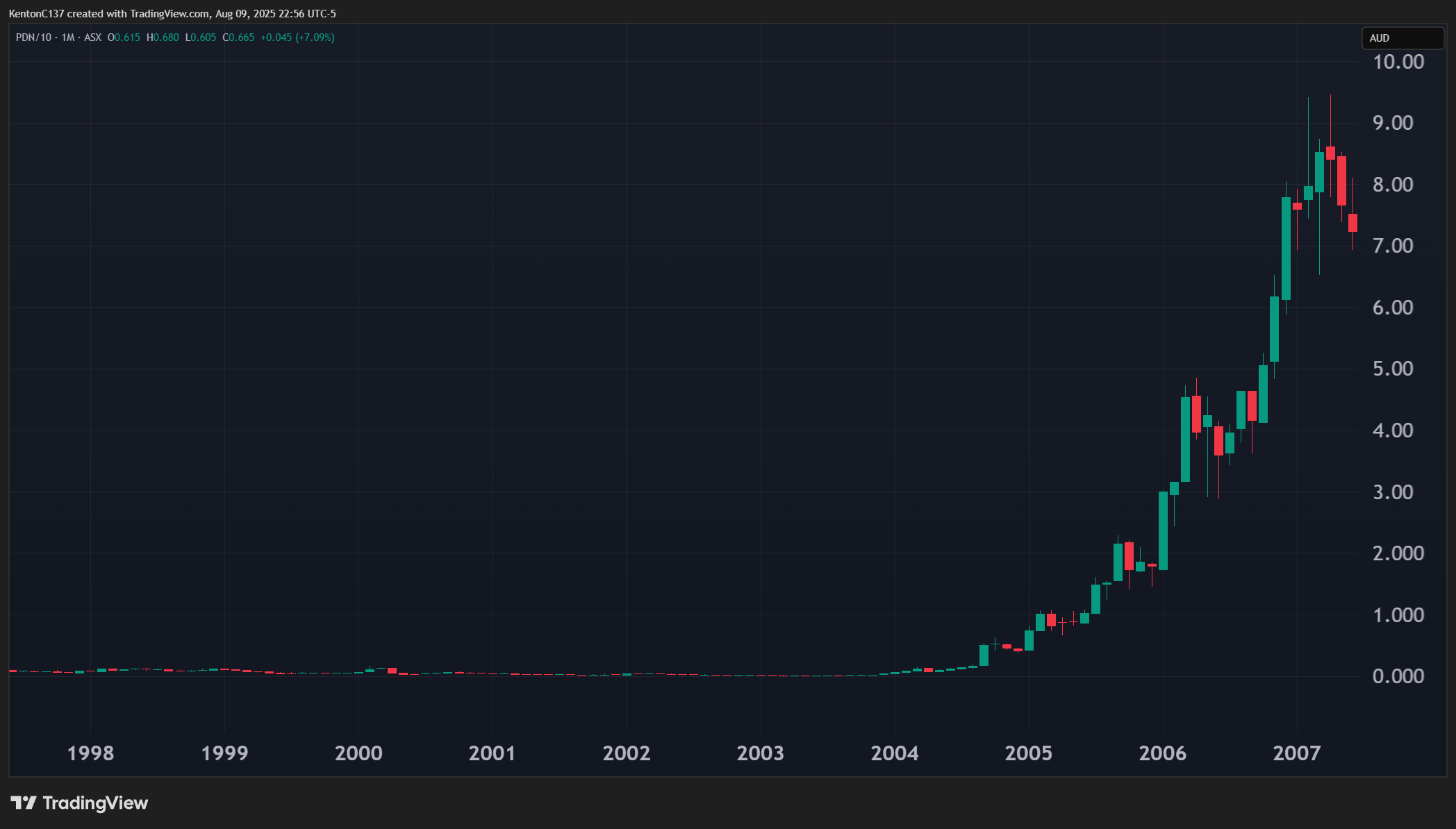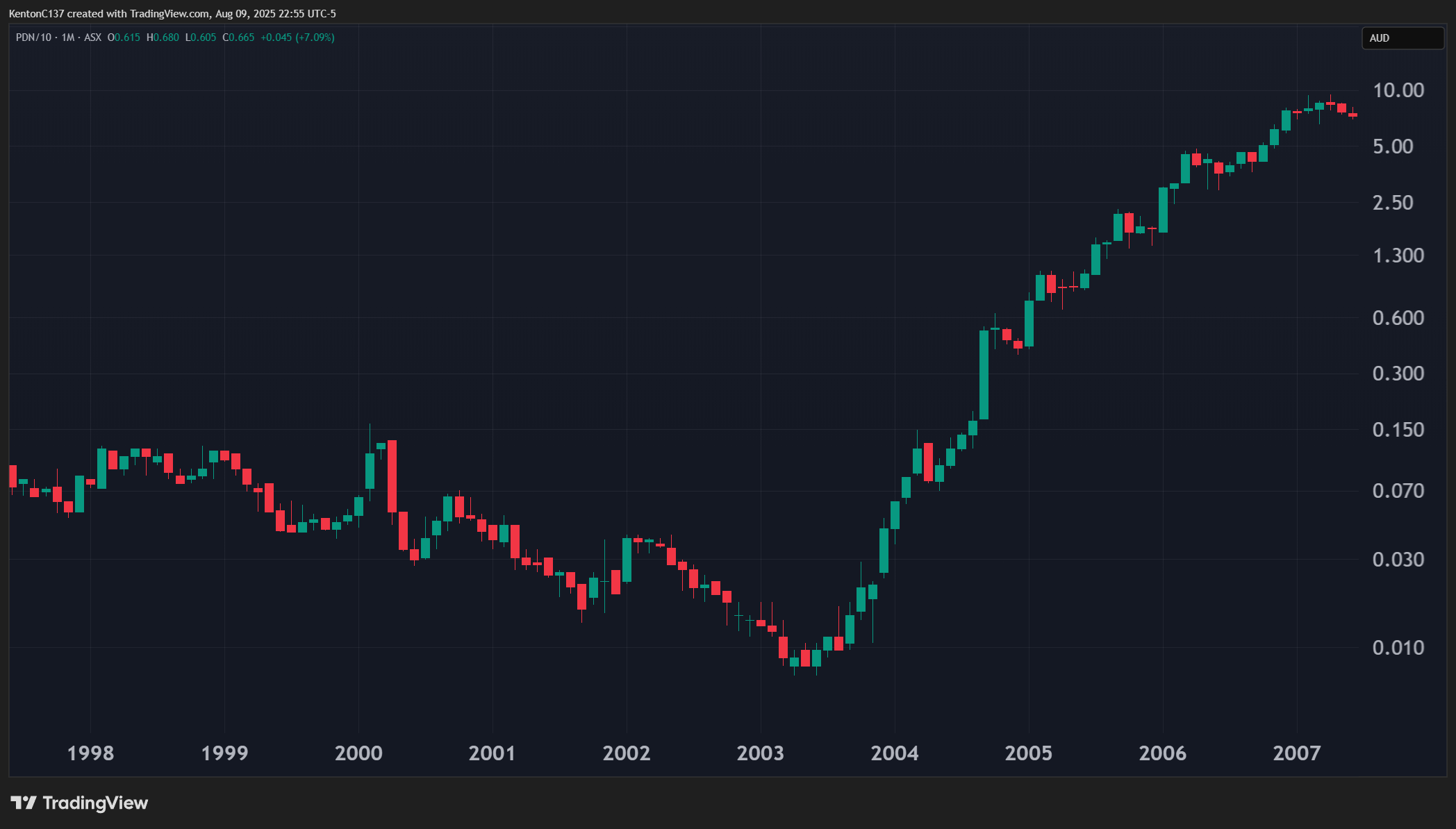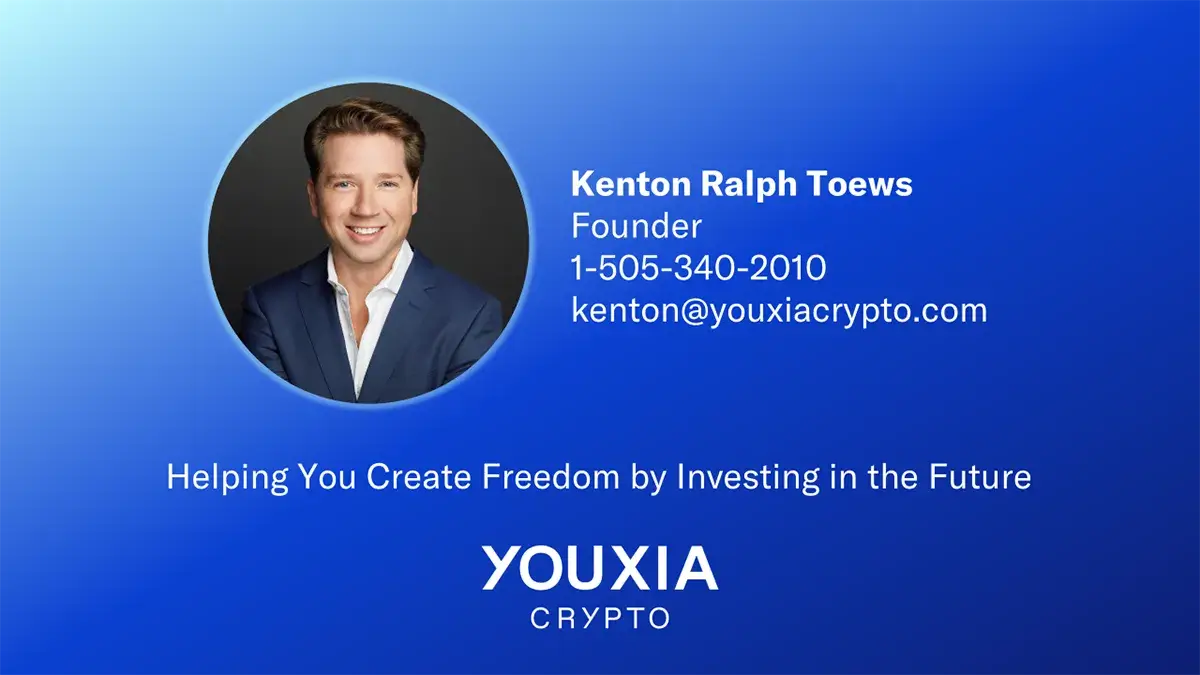
GENERAL,THORCHAIN
THORChain $1 to $1,000
August 29, 2025
Rick Rule is one of the most successful mining stock promoters of our time.
His career spans 5 decades and is widely recognized around the globe as one of the most influential people in the sector.
Rick’s specialty is raising money for mineral exploration companies which has given him a front row seat to all the major discoveries in the world. His success is amplified by all the interviews and speeches he gives about investing in commodities.
For 10 years I worked with Rick out of his Sprott USA office in Carlsbad, California. It was a great experience to learn from a legend and hear all the stories from his tenured career.
There’s one story in particular that Rick has told over and over again and still to this day, no matter how many times people have heard him tell it, they can’t get enough of it. It’s like watching Dumb and Dumber. No matter how many times you watch it, it’s still funny.
What story am I talking about?
Paladin Energy - 10 Cents to 10 Dollars
Rick has told this story probably a thousand times now over the last 15 years. I’ve heard it so often that I feel like I actually lived it.
You can listen to the story from the horse's mouth in this video interview.
Following is a paraphrasing of it:
If you’re a natural resource investor, because of the cyclicality and the capital-intensive nature of the industry, you’re either a contrarian or a victim. Those are your two choices. You need to invest and speculate in sectors that are out of favor, hopefully, decidedly out of favor. And when the price of the commodity and the shares rise, you need to remember that these aren’t self-fulfilling prophecies, that markets work. So when something’s unpopular, you have to buy it, and when it becomes popular, you have to sell it. And those are both very, very, very difficult lessons to learn.
In the late 90’s, uranium was perhaps the ultimate contrarian investment. It had been in a bear market for 20 years, going all the way back to Three Mile Island. What that meant was that investment interest in uranium was nonexistent. The chart of the commodity itself or those few companies that remained looked like the electrocardiogram of a corpse. People were afraid of it. When you talked about investing or speculating in uranium, certain members of the audience would suggest that you’re profiting from Chernobyl, Hiroshima, Nagasaki, and Three Mile Island. Now, perversely, if you’re a contrarian, that’s the best possible sign. Because you know that you have absolutely no competition whatsoever. The entry point wasn’t cheap, it was free.
On a global basis, we were producing uranium at a total cost of about $30 a pound and selling it for $8 a pound. The industry was losing in excess of $20 a pound and doing it 150 million times a year. That belied the fact that uranium was and is the cheapest source of baseload power in the world. Either the price of uranium had to rise to the point where the industry would earn its cost of capital or the lights would go out. I thought it was more likely that the price would rise than the lights go out
Unfortunately, I came to this conclusion for myself four years early.
There’s a joke that on an 8% discounted net present value basis, four years early isn’t early, it’s wrong. But if you go back to the point in time where I made that investment, there were only 5 uranium juniors in the world that had survived a 20-year bear market. There were only 15 management teams in the world that were capable of running a uranium company, and there was no competition for the stocks. I thought that the uranium price could go from $10 to $30. I was wrong. It went from $10 to $145. The worst performing of the uranium juniors that I owned, went up 22x from its bottom. I’m not trying to say, by the way, that I bought all my stock at the bottom or sold all my stock at the top, that didn’t happen. But the truth is, there was a hell of a lot of money to make in the middle.
The most instructive was Paladin Energy.
Paladin was a little Australian penny dreadful, run by an amazing man named John Borshoff. Its principal asset was a database compiled by the West German government at a cost of a billion dollars. They gave it to Mr. Borshoff as a severance benefit when they laid him off, because they didn’t care about uranium anymore. I led a private placement at 10 cents a share. I was rewarded for my genius by watching the stock go from 10 cents to 12 cents, then collapse down to 11, 10, 9, 8, 7, 6, 5, 4, 3, 2, 1. Ten cents to a penny. If you have a 90% embedded loss in a position, you don’t have a hold, you have a buy or you have a sell. You’re either wrong, in which case you salvage those few pennies you have left, or you’re right, in which case, you buy a lot of stock.
I reassessed the situation, I decided I was right, the market was wrong.
I bought a bunch more stock at a penny and a half, two pennies, three pennies, and four pennies. Within five or six years of bottoming at a penny, the stock reached $10. Now, I’m not going to suggest to you that I held my whole position and sold at $10. That didn’t happen. If you own stock at an average of a dime, when you see a $1 bid, you sell enough to recoup your capital and pay your capital gains tax. When you think that the price of uranium can go to $30, and it’s $60 bid, you begin to sell the rest, which I did.
The instructive part of the lesson is that a stock is more attractive at a penny than it is at 10 cents if everything else stays the same. What other people might call a bear market, an intelligent speculator calls a sale. And goods on sale are good. You need the psychological staying power to be right. You need the honesty to admit that you’re either right or wrong. And when the price action that you’ve enjoyed justifies the narrative, which is to say when you start feeling smart, you need to begin to think about selling.
At the bottom of the market, there were 5 uranium juniors worldwide, and 15 management teams that were capable of running a uranium company. That means the probability that your company had a good management team was a function of dividing the number of teams available (15) by the number of companies (5). So the probability that a uranium junior was well run was 100%.
At the top of the cycle, there were 500 companies purporting to be in the uranium business. But the number of capable management teams didn’t change. So the probability that your junior was well run, was again, a function of dividing the number of management teams (15) by the number of companies (500). The probability that your uranium junior was well run was very close to 0%.
When the investment was at its most popular, it was the most lethal. And when the investment was totally unpopular, hated, there was virtually no way to lose money.
Paladin Energy Stock Chart
The first image is the linear price chart of Paladin Energy (PDN:ASX). The second image is the log price chart of PDN. I divided the share price by ten to take into account a reverse stock split, so you can actually see the share price follow the path Rick described above.
Everyone in crypto is used to looking at log based price charts because of the exponential growth of token prices. Before bitcoin was even a glimmer in Satoshi’s eye, you needed log based price charts to evaluate junior mining stocks too.
There’s more in common between the junior mining industry and crypto than you might think. On the surface, mining exploration and crypto are completely different. But from the business and investing side of things, they’re very similar. Same strategies, same personalities, and same problems.
Paladin Energy Fundamentals
Paladin at 10 dollars was a completely different company than Paladin at 1 penny.
When Paladin was trading for a penny all they had was a database of uranium properties. Just because a billion dollars went into making it, didn’t mean the company was worth a billion dollars. Land had to be acquired, core samples drilled, resources defined and converted into reserves, engineering studies done to design a mine, financing and permits acquired to build it, and much more in between. These are all costs that Paladin had to stomach (through dilution) to move things forward.
Paladin went from one man with a database to producing 2% of the world's uranium supply. The journey saw the share price drop 90% before later rallying 100,000%.
The uranium price going from $10/lb to $145/lb most certainly helped fuel the rise in Paladin’s stock. Moves like that don’t happen very often, they occur once every couple decades.
It’s one of the reasons Rick has been telling this same story for almost 20 years now, because stories like this don’t come around that often.
All the stars have to align for a success like Paladin.
THORChain Fundamentals
I believe the stars are lining up for THORChain (RUNE) just like they did for Paladin and the stories between the two are quite similar.
Crypto has been viewed as radioactive by mainstream investors since bitcoin was invented. The average person is terrified of crypto because of meltdowns like Terra LUNA, Celsius, and FTX. Only in the past 6 months has that narrative started to change with the US government becoming crypto friendly.
The traditional financial system (TradFi) is getting closer to its breaking point. Fiat money will collapse; it's just a matter of time. The real question is what will replace it? Will humans go back to adding up sea shells with an abacus or will society adopt a new and more advanced system (i.e.) DeFi?
Alt-coins are still in a bear market. Sentiment is quite negative because it’s mainly the bitcoin and ethereum prices that are moving up.
The RUNE price is hovering just over $1, about 90% below its high.
Decentralized exchanges (DEXs) are nowhere near as popular as centralized exchanges (CEXs).
THORChain is 1 of only 5 cross-chain DEXs and there are maybe 15 developer teams in the world who understand the technology. So the chances of the developers working on THORChain being the best in the world are 100%.
THORChain doesn’t have all kinds of things to do like Paladin did. The mine, so to speak, is already built and in production. Just updates and improvements are continuously being done. No further dilution is needed to advance the project, all the tokens are free trading, and the supply is actually deflationary.
The only question that remains for THORChain is how big can it get?
Billion Dollar Database vs. Billion Downloads
Paladin’s database is what made it possible to succeed and do well. The database by itself couldn’t produce any uranium, it just told you where it was. Humans had to utilize this information to go and extract the metal from the ground.
The ingenuity of using the information in the database to its fullest extent is what made Paladin a success. Had the team not found a way to utilize the data, their share price would have told a completely different story.
THORChain doesn’t have a database per se like Paladin. However, it has been integrated into wallets with over 300 million downloads. At the current growth rate of those downloads, new integrations, and the growth of crypto in general, THORChain is on pace to be integrated into wallets with a billion downloads over the next several years.
To put these numbers into context, THORChain only had 0.03 million users last month. That’s 1% of 1% of 300 million.
If only 1% of those 300 million wallets started using THORChain, that would be a 100x increase in users. If 1% of a billion wallets started using THORChain that would be a 333x increase in the number of users from today.
What if it’s 2%, 3%, or more?
Coinbase’s monthly average is about 6% of its total potential user base.
When talking to a business development person at Trust Wallet they told me only a total of 1% of their users have ever traded within the wallet. And the vast majority of the users they talk to have no idea they’re able to swap within the wallet. There’s a big disconnect and Trust is trying to figure it out.
THORChain is going to try figuring it out too.
ADR021
THORChain nodes just passed ADR021. It’s an approval for 5% of the network revenue to go towards a dedicated marketing fund. The goal of this fund is to get new users on THORChain, grow the volume, and in turn drive up the RUNE price.
THORChain has to figure out a way to capitalize on the hundreds of millions of wallet downloads, just like Paladin found a way to capitalize on its database.
The users of these crypto wallets obviously want to have self-custody of their crypto, otherwise they wouldn’t have downloaded the wallet in the first place. These users also trade/swap their crypto. So it makes perfect sense that they would want to swap within their wallet too. The problem is they don’t know they can do it.
ADR021 aims to solve this problem by putting resources towards proper marketing to communicate this message to the masses and make THORChain a serious contender to become one of the biggest crypto exchanges in the world.
THORChain doesn’t have to become the biggest exchange in the world to succeed, it just has to get close. Paladin became the 9th largest uranium producer at its peak. No one complained about that.
Competition is always a concern. However, there are hundreds of CEXs competing with each other right now, yet Binance is still worth over $100 billion, and growing. There could be hundreds of DEXs competing with each other and the RUNE price still does well. THORChain was the first cross-chain DEX, so it has a big head start in network effects, helping it stay ahead of the pack.
RUNE: 1 Dollar to 1 Thousand
CZ from Binance believes DEXs will eventually dwarf CEXs because decentralization is the whole point of crypto and it’s what the industry is progressing towards. Therefore, it stands to reason DEXs will become worth as much, if not more, than CEXs one day.
If THORChain were to have the same market cap of Binance, RUNE would be $345.
That’s based on today’s market cap for Binance. What happens when crypto goes mainstream and is embraced by the world rather than shunned? What happens when the fiat monetary system fails and the world switches over to DeFi?
Binance could double or triple in valuation, making the equivalent RUNE price $690 or $1,035. That’s assuming THORChain is the same size of Binance, let alone bigger.
Those numbers sound too fantastic?
Is it any different than uranium going from $10/lb to $145/lb and taking Paladin from a penny to ten dollars?
A lot can happen in 4 years.
The surge in the uranium price didn’t happen in isolation. It occurred within a massive commodity bull market caused by China’s population entering the middle class. Most commodities and their related stocks boasted tremendous returns during the period.
The set up in crypto is just like the early 2000’s in commodities.
Altcoins are on the verge of a bull market as the world begins to embrace crypto for the first time. The US government is making it much easier for the country’s middle class to invest in crypto as it does a total 180 on its previous stances. Even 401k’s are now allowed to invest in the sector.
Set ups like this only come around once every couple decades and time is running out if you want to get in while RUNE is cheap.
There are several new features coming out on THORChain this fall that should increase volume and, for the first time, there will be proper marketing done to promote it.
Youxia RUNE Fund
The Youxia RUNE Fund invests in RUNE and uses the tokens to run nodes on the network and collect yield. The yield is from real people paying real money to use the exchange. There are no block rewards. The Fund is compounding the yield until it makes sense to distribute it as income.
The upside potential in the RUNE token is equally matched with the upside potential in the yield.
$1 invested today could end up yielding $1/year, maybe even $1/month if everything falls into place.
You don’t need any experience with crypto to invest in the Fund and you can do it in about 20-30 minutes. You’ll be immediately invested in one of the highest quality cryptocurrencies and positioned for the bull market.
Contact me to get started.
Thank you for reading.
I’m the founder of Youxia Crypto, an asset management company specializing in crypto. I can help you buy and sell precious metals too. I believe crypto is more than just about trying to make money, it’s about creating freedom for oneself and the rest of the world. I’m a contrarian, voluntaryist, and proponent of Austrian Economics. I enjoy skiing, beach volleyball, scuba diving, live music, yoga, and traveling.
The intended use of this material is for informational purposes only and is not intended to be an offer or solicitation for the sale of any financial product or service or a recommendation or determination that any investment strategy is suitable for a specific investor. Investors should seek financial advice regarding the suitability of any investment strategy based on the objectives of the investor, financial situation, investment horizon, and their particular needs. This information is not intended to provide financial, tax, legal, accounting or other professional advice since such advice always requires consideration of individual circumstances. The investments discussed herein are not insured by the FDIC or any other governmental agency, are subject to risks, including a total loss of the principal amount invested. Past performance is no guarantee of future returns.





